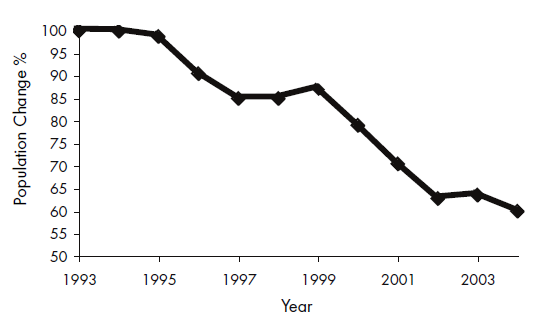Graph of the Day: Population Change of Athabasca River Caribou, 1993-2004
Woodland caribou is one of the species likely to be extirpated from regions subjected to Steam Assisted Gravity Drainage (SAGD) development. Caribou declines across Alberta have been correlated with the level of industrial development within their ranges.43 In the past ten years, the East Side Athabasca River caribou herd, whose range overlaps much of the current SAGD development, has declined by almost 50% (Fig. 16). Studies have shown that forests within 1 km of roads and well sites tend to be avoided by caribou44 and that roads further fragment caribou habitat by acting as barriers to movement.45 It is believed that this fragmentation concentrates woodland caribou into smaller portions of their range, where they become more susceptible to predation by wolves.46 Three separate studies predict dire consequences for caribou under the current management regime. A government-led study concluded that woodland caribou will continue to decline unless limits to development and aggressive restoration of existing disturbances are implemented.47 An industry-funded modeling study within the oil sands region determined that, due to projected industrial development, available caribou habitat will decline from 43% of the landscape to 6% over the next 20 years.48 Finally, a study at the University of Alberta concluded that caribou will be extirpated from northern Alberta in less than 40 years if linear densities exceed 1.2 km/km2 (less than half the projected linear density within SAGD developments).49 The consistent message is that, unless significant changes are made in the way we allocate and develop land for in situ oil sands production, caribou are likely to be lost from the entire oil sands region. …
Death by a Thousand Cuts: Impacts of In Situ Oil Sands Development on Alberta’s Boreal Forest [pdf]
